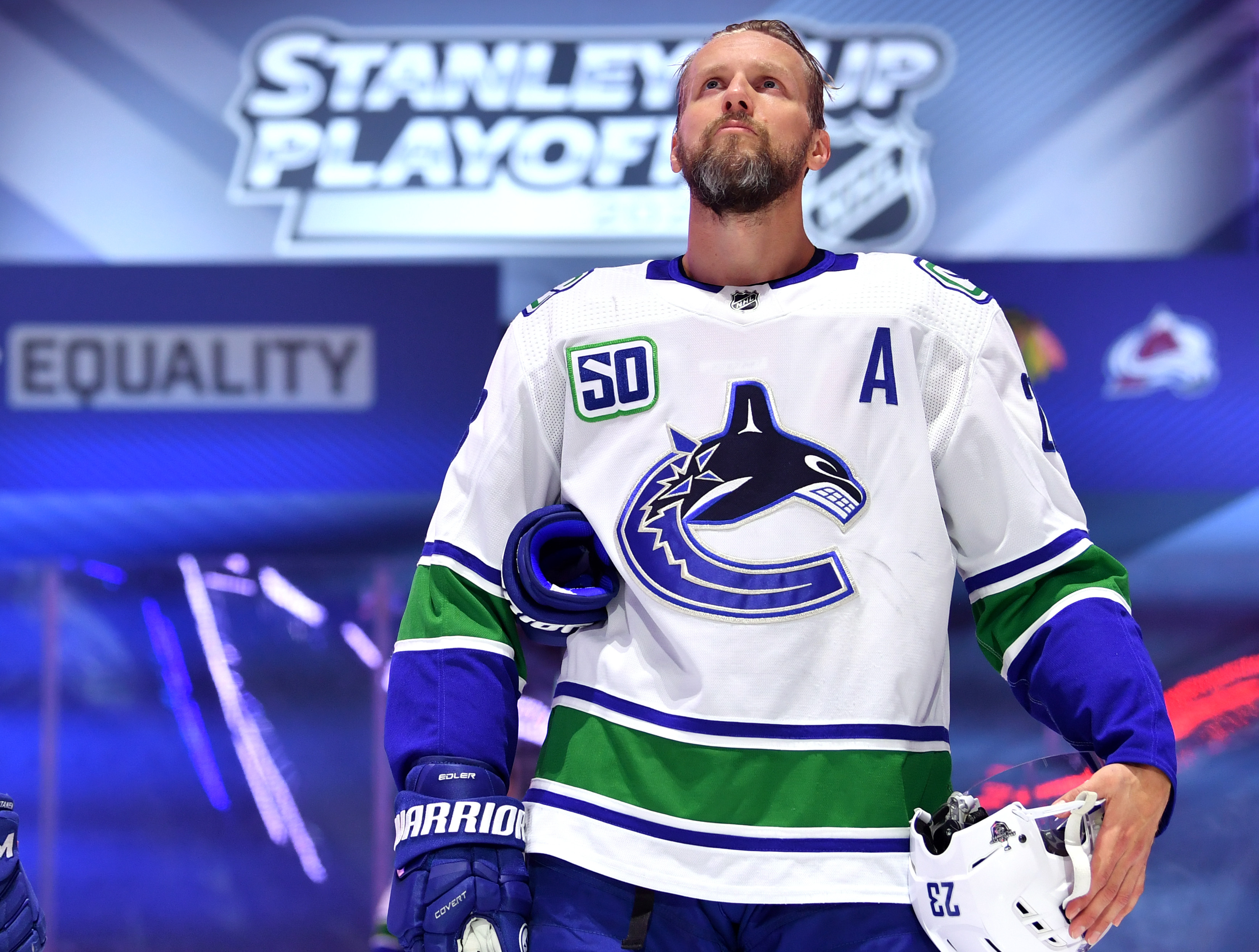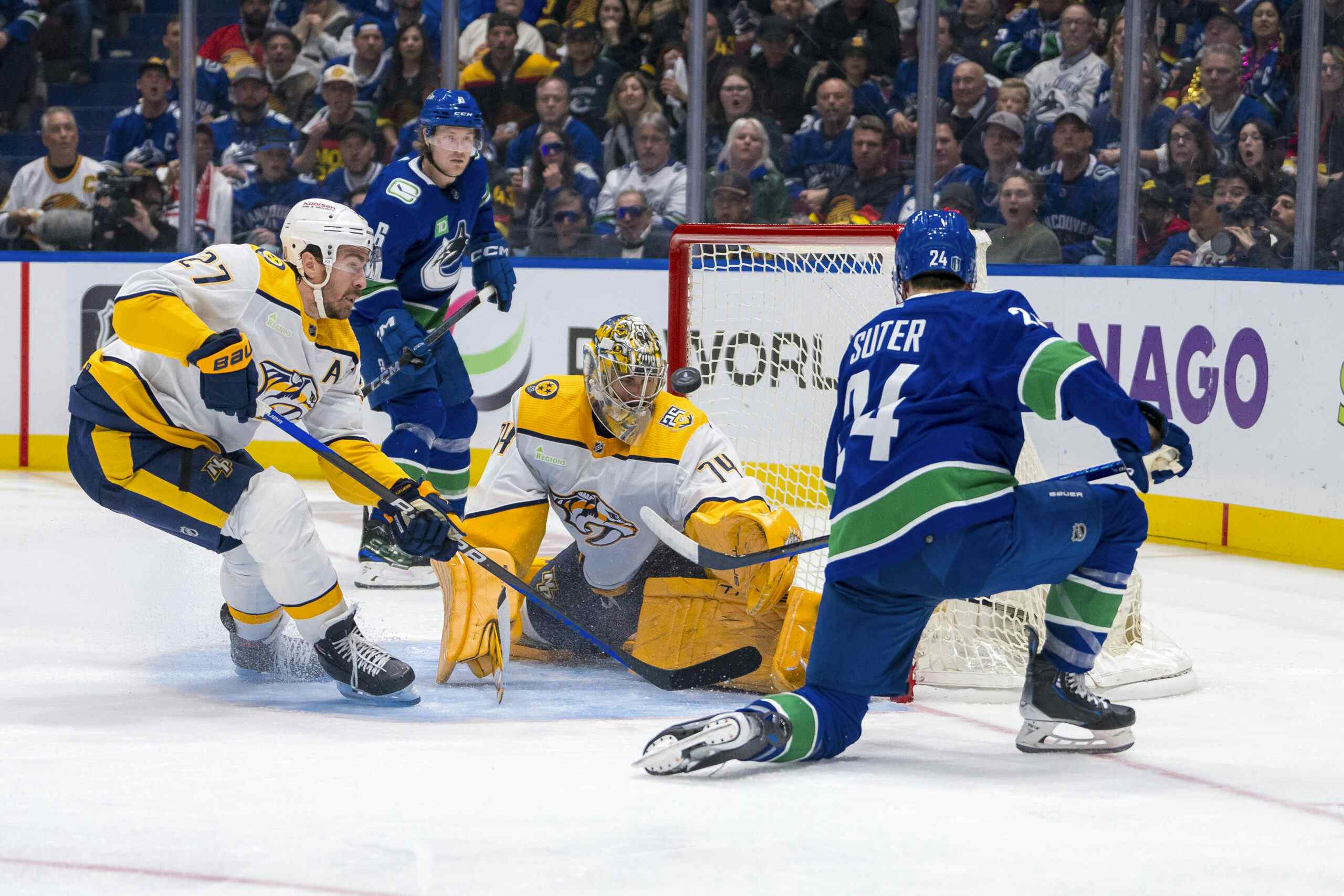Alex Edler’s defensive work at even strength in the playoffs was crucial, but his special teams play suffered

By Kevin Wong
3 years agoThe Vancouver Canucks’ longest-serving roster member, Alex Edler, remains the team’s best shot blocker and a very crucial defensive presence for the club. However, amidst the team’s search for increased production and transition ability from the back end, there are questions around his suitability as an offensive player. The reality may be that he was always somewhat miscast, and this year has now seen his offensive opportunities reduced in significant ways.
Once a powerplay staple, Edler saw his powerplay time reduced to a mere 8:08 in the 36 regular season games he played after the team’s tilt against the Nashville Predators on November 21, 2019. We can contrast that with Tyler Myers’ 61:41 and Quinn Hughes’ 166:39 total powerplay minutes after November 21. This continued into the start of the playoffs, when Edler received just 5:11 of PP TOI in the first six games, third among defencemen.
Hughes and Myers are now the team’s two preferred powerplay defencemen. However, due to the latter’s injury in Game Two against St. Louis, Edler became the Canucks’ second-unit quarterback in the team’s final stretch of 2020 postseason play.
In 20:49 of PP TOI in the playoffs with the second powerplay group, Edler collected zero powerplay points. Likewise, Myers collected no powerplay points. We must acknowledge the weakness of the second unit relative to the first as well as the ice time discrepancy as major reasons for this lack of offensive production.
The Canucks’ offence is very top-heavy, and the team lacks scoring depth.
Fortunately for Edler, 26 of his 33 points this season were recorded at even strength. All of his points this summer were collected at even strength. He continued to produce at a thirty-point-over-82-game pace during the playoffs with seven assists in 17 games, and was tied with Chris Tanev in team scoring. Both remain tied for fourteenth among all NHL defencemen in 2020 playoff scoring.
Five of Edler’s seven playoff assists, however, were secondary assists with the primary assists being awarded to some of the team’s dynamic, offensive players. Edler himself does not generate offence through the neutral zone or by initiating creative maneuvers in the offensive zone. Instead, he typically clears the puck out of his zone and allows his forwards to attack.
His heavy slap shot, which once registered at 103 miles per hour in 2009-10, is no longer a threat. He scored five goals in 2019-20. In the Canucks’ 2018-19 Super Skills competition, his two attempts were clocked at 94.2 and 94.1 miles per hour, respectively. The year before that, his two shots registered at 97.4 and 96.6 mph. The notion that he still possesses a 100 mph slap shot is quite likely false, and he rarely utilizes his one-timer.
Edler’s primary contribution at the point is his lofting of the puck towards the opposing goal with the hope that the Canucks can either deflect it or generate an opportunity in the crease. In many cases, the opposition simply knocks the puck down and clears it away. Sometimes, however, the puck goes through and creates a scramble play.
While Edler takes more shots than any of the Canucks’ defencemen, he is not a high-volume shooter nor are his shots deliberate scoring threats.
Physicality itself is not an essential element for every defenceman — consider Chris Tanev, for example — but a slower blue-liner such as Edler may compensate for his lack of speed with the ability to separate the opponent from the puck along the boards. Over the past three seasons, in particular, he has played a more physical game than in the past.
He was the team’s third-most-physical defenceman in the playoffs with an average of 5.47 hits per 60, behind both Oscar Fantenberg and Jordie Benn. This placed him 73rd among defenceman in hits per 60 during the 2020 playoffs. During the regular season, his 4.85 hits per 60 placed him 81st among defencemen who played 20 or more games. His use of physicality is selective. Tyler Myers, not known for his body checking, was nearly as physical with 4.06 hits per 60 in the regular season. Neither are particularly aggressive.
Edler registered a very low takeaway total in the playoffs, but rather than strip the opponent of the puck with his stick, he was often able to contain the opponent reliably using his strength. His defence partner will usually collect the loose puck. Below is footage of one of his better performances, Game Five against the Vegas Golden Knights.
Alex Edler’s performance in Game 5 vs VGK (Sep. 1, 2020) – Part 1:
There were games during the playoff campaign when Edler was less engaged than usual, and an infamous giveaway gaffe against the St. Louis Blues in Game Two is emblematic of some of his more frustrating moments. Chris Tanev repeated this in Game Three. Game One against Vegas was another game in which he, and the whole team for that matter, moved the puck sloppily.
Alex Edler’s contributions as a shot-blocker deserve great attention. He blocked 67 shots in the postseason and averaged 10.27 shot blocks per 60 minutes of ice time, more than twice that of any of the Canucks’ regular defenceman except Chris Tanev. Edler was ranked third in the entire NHL in shot blocks in the 2019-20 regular season. Tanev was ranked fourth.
On the other side of the puck, Edler occasionally joins the forecheck and provides puck support down low in the offensive zone. There are often times when the Canucks’ forwards need additional help along the boards, and Edler still pinches quite effectively to ensure that his team maintains control of the puck. His 6’3” frame and relative strength allow him to apply pressure against the opposing puck carrier. During this year’s playoffs, they actually generated more shots on goal per 60 at even strength when he was on the ice than any other Canucks defenceman.
Overall, he had an Unblocked Shot Attempt Percentage of 45.7%, second-highest among defenceman on the team behind Quinn Hughes. This metric does not bode well for the Canucks, all of whom registered sub-50% measurements and some sub-40%. They were out-possessed by both the Blues and Golden Knights, and the Knights badly out-shot the Canucks as well.
In terms of possession, however, the Canucks were only better when Hughes was on the ice. The team’s lack of possession is a matter involving all five skaters on the ice, but relative to the other defencemen, the ice was slightly less tilted whenever Edler was on the ice.
In our footage, we rarely see the Canucks trapped in their own zone at even strength. The puck usually enters the zone and then is cleared. In our previous look at Game One against the Vegas Golden Knights, we saw the degree to which the opponent could dominate possession.
Vancouver also scored four more goals than they allowed at even strength with Edler, the second-best EV goal differential compared to the team’s other defencemen and 20th among all NHL defencemen (with a sample size of seven games or more) in the 2020 playoffs at the time of this article’s publication.
In five-on-five situations, the Canucks experienced relative stability whenever Edler was present. He was the team’s minutes leader with 391:04 of TOI including a team-leading 307:15 of even-strength TOI, or 18:03 of EV TOI per game.
The Canucks’ penalty kill was mediocre, however. Edler and Tanev logged a majority of the minutes on the team’s 16th-ranked penalty kill. Among all penalty-killing defencemen in the playoffs, Tanev and Edler were on the ice for more powerplay goals against than anyone else: Tanev’s 12 were the most, while Edler’s 11 placed him third on that list. In terms of PP goals against per 60, Edler ranked 14th-highest among defencemen with at least seven games played, although only players from Arizona, Dallas, Colorado, Carolina, Chicago, St. Louis and the Islanders ranked above him.
Some of those teams, not surprisingly, were among the bottom-ranked penalty-killing units in the playoffs. To be competitive, the Canucks need to be better at killing penalties. Alex Edler, Chris Tanev, Tyler Motte, and Jay Beagle were the Canucks’ four most-frequent penalty killers and the on-ice culprits on most occasions when the opponent’s powerplay scored. Edler particularly struggles once he begins to chase in the defensive zone or when the opponent is too fast to contain off the rush.
Alex Edler’s performance in Game 5 vs VGK (Sep. 1, 2020) – Part 2:
As far as his defensive zone breakouts are concerned, Edler’s long-range outlet passes are often less precise than one would hope, but when he keeps his passes simple he moves the puck effectively. He reliably clears it out of his own zone at even strength, but his offensive vision is somewhat limited. At this point, he does not create much offensively nor does he spend too much time hemmed in his own zone in five-on-five situations.
He was one of the Canucks’ best defencemen on the defensive side of the puck during the postseason, although his play was still not ideal. His overall lack of offence, as well as the team’s relative weakness on the penalty kill necessitates some consideration as to what his future capacity with the team might be. He is entering the final year of a two-year contract with an AAV of $6 million.
This contract was signed before Quinn Hughes’ arrival, and so his next contract might reflect his new place on the depth chart. Canucks fans may recall past seasons when he was less-than-stellar defensively, but during this year’s playoffs, and during the 2019-20 campaign as a whole, he proved that he can remain a reliable and stable contributor under comfortable circumstances. At 34 years of age, there still may be a few more years remaining in the tank.
Grade: B
Recent articles from Kevin Wong
- Loui Eriksson was the Canucks’ least engaged and productive forward of the 2020 playoffs, and he’s signed for another two seasons
- Brandon Sutter was among the Canucks’ best playoff back-checkers, but his cap hit remains a hindrance
- Alex Edler’s defensive work at even strength in the playoffs was crucial, but his special teams play suffered





